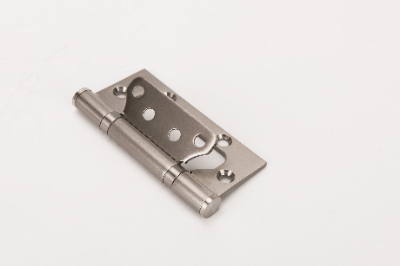What Is a Spring Hinge?
 A Spring Hinge is a combination of a hinge spring and a coil spring.
A Spring Hinge is a combination of a hinge spring and a coil spring.
Spring hinges are mainly used as a rotating mechanisms for doors and other devices that are to be closed automatically. If an external force is applied to change the angle, it has a function to return to the initial angle by the restoring force of the spring when the external force is released.
By utilizing the return function of hinge springs, doors can be opened and closed only by opening and closing. By using a spring hinge as an appropriate rotating mechanism, many advantages can be obtained, such as increased work efficiency, improved usability, and the prevention of forgetting to close the door.
Uses of Spring Hinges
Spring hinges are used in many products around us, such as the lids of mailboxes and the tops of trash cans. They are often used in parts that can be moved with relatively small force, and are one of the inexpensive components that play a major role.
In addition, they are sometimes used for industrial machine parts. They can be easily clamped by the force of coil springs when temporarily fixing processed materials, contributing to improved workability.
Spring hinges are installed in the same way as normal hinges, by fixing one plate to the fixed side member and the other plate to the rotating member.
Principle of Spring Hinges
When the side member is fixed and external force is applied to the rotating side member, the rotating side member rotates with the axis connecting the two plates as its rotation center, and the coil spring deforms at the same time. When the external force is released, the restoring force of the spring hinge causes it to return to its original angle, and the rotating member returns to its original position.
Structure of Spring Hinges
Spring hinges have a simple structure in which a coil spring is passed through the shaft portion called the pin of an ordinary hinge, and both ends of the spring are fixed to the plates on both sides of the hinge.
When the spring hinge is deformed, elastic energy is accumulated by twisting the coil spring, and when the external force is released, it acts as an elastic force and returns to its initial position.
Repeated opening and closing of the hinges causes wear on the shaft of the hinge and the tube that receives the shaft, resulting in unstable operation when opening and closing the hinges. Proper lubrication is necessary to prevent wear.
In addition, not only the shaft part but also the spring can be damaged by corrosion, and the spring can become weak due to repeated operation. Therefore, the moving part often reaches the end of its life before the mounting part.
Other Information on Spring Hinges
1. Installation of Spring Hinges
Generally, a hole is drilled in the hinge side for mounting, and it is fixed with screws or rivets to the fixed side member. If the fixing member is metal, it may be fixed by welding with a hinge that does not have a hole in it.
While screws and rivets often lose their fixing strength after repeated use, welding can maintain its fixing strength over a long period of time. Although there are many doors around us that close automatically, the restoring force of a coil spring installed in a spring hinge with a shaft length of only a few millimeters is limited, so it cannot be used for doors that require a large force to return to the initial position.
However, it may be used for relatively lightweight doors. Door closers that combine a spring and damper are often used for doors that are relatively heavy, such as doorways. In such cases, an additional place for mounting the device must be provided.
2. Adjustment of Spring Hinges
By changing the initial angle and wire diameter of the coil spring, the initial angle and the strength of the restoring force of the spring hinge can be adjusted. However, if the restoring force of the spring is set to a large value, the force required to deform the spring will also increase, so the size of the force to open the door must be considered.
In addition, if the restoring force of the spring is set too large, there is a high risk of injury due to fingers being caught when the door closes. Safety considerations should also be taken into account, and if necessary, protection with rubber material or installation of a damper is necessary.
3.Application of Spring Hinges
When spring hinges are installed, the elastic energy stored in the spring is released unilaterally, but there are hinges that have a damper built into the hinge.
There are also spring hinges that apply the energy of the spring to enable heavy doors to be opened with little force, and spring hinges that allow the strength of the spring to be adjusted in steps. Even simple spring hinges can adjust the closing strength of a door by adjusting the number of pieces attached to the door.